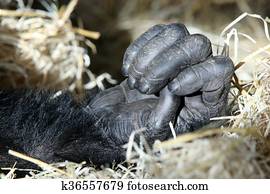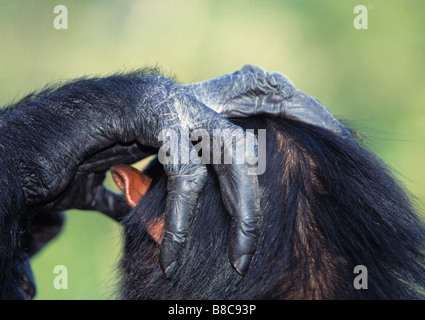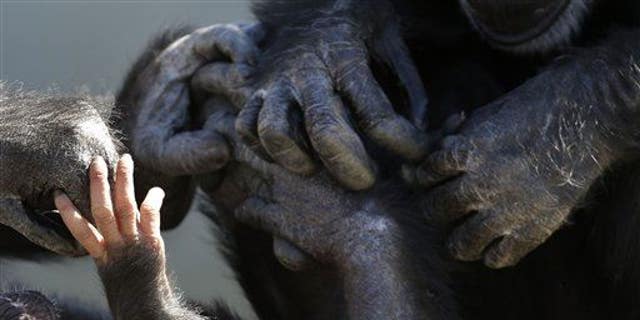


However, later discoveries of Miocene hominoid fossils preserving primitive postcranial morphology relative to extant hominoids suggested that the anatomical correlates of below-branch suspension might have evolved multiple times throughout hominoid evolutionary history ( 2– 4, 17, 18). The shared aspects of hand and wrist morphology among humans and nonhuman hominoids, especially the African apes, supported Keith’s hypothesis ( 6) that humans evolved from a hominoid-like ancestor. Humans also share with chimpanzees, bonobos, and gorillas the fusion of the os centrale and scaphoid ( 1, 13, 15), which increases midcarpal joint stability and decreases joint stress ( 1). Furthermore, humans and other hominoids share an intra-articular meniscus on the ulnar side of the wrist responsible for isolating the ulnar styloid process ( 14, 16). For example, although humans have an intrinsically elongated thumb compared to most hominoids, the lengths of the nonhuman hominoid pollical metacarpal and phalanges are not reduced relative to their body size ( 13). The recognition that human and suspensory hominoid hands are specialized in seemingly divergent directions influenced the development of an alternative hypothesis in which humans evolved from a quadrupedal, cercopithecoid-like ancestor instead of a suspensory, hominoid-like one ( 10– 12).ĭetailed comparative research demonstrated that the hands of humans and cercopithecoids are only superficially similar in morphology ( 13– 15). In these features, humans were argued to more closely resemble cercopithecoid primates than hominoids ( 10– 12). For example, Pan, Pongo, and Colobus have a markedly reduced thumb, and Ateles and Brachyteles have entirely lost an external thumb ( 8, 11). The most suspensory hominoids, cercopithecoids, and platyrrhines tend to display a reduced pollex and narrow, elongated nonpollical rays. The morphology of the highly dexterous human hand, with its intrinsically elongated first ray (pollex or thumb), shortened metacarpals and nonpollical digits, and hypertrophied thenar muscles, contrasts sharply with that of suspensory adapted anthropoid primates ( 8– 10). Keith ( 6) established the hypothesis that human postcranial anatomy was derived from an orthograde ancestor, later interpreted as a “brachiating” ancestor ( 7), by highlighting the aspects of trunk and limb anatomy shared among humans and other hominoids. The recognition that humans are closely related to African apes influenced the range of possible explanations for bipedalism by raising questions about the kind of ancestor from which the human bauplan was derived ( 1). Numerous adaptive explanations for bipedalism rely on an understanding of our place in nature. The morphology and inferred positional behavior of the last common ancestor (LCA) of humans, chimpanzees, and bonobos (hereafter, “LCA”) are critical for understanding the evolution of hominin bipedalism ( 1– 5). Overall, our results suggest that early hominins evolved from an ancestor with a varied positional repertoire including suspension and vertical climbing, directly affecting the viable range of hypotheses for the origin of our lineage. We identify an evolutionary shift in hand morphology between Ardipithecus and Australopithecus that renews questions about the coevolution of hominin manipulative capabilities and obligate bipedalism initially proposed by Darwin. Here, we use morphometric and phylogenetic comparative methods to show that Ardipithecus retains suspensory adapted hand morphologies shared with chimpanzees and bonobos. However, the hand of the 4.4-million-year-old hominin Ardipithecus ramidus purportedly provides evidence that the hominin hand was derived from a more generalized form. Early 20th century anatomical research supported the view that humans evolved from a suspensory ancestor bearing some resemblance to apes.

The morphology and positional behavior of the last common ancestor of humans and chimpanzees are critical for understanding the evolution of bipedalism.


 0 kommentar(er)
0 kommentar(er)
